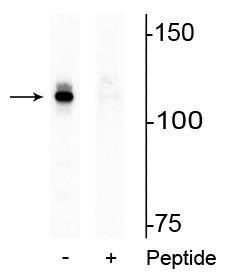Anti-Androgen Receptor (Ser94) Antibody
Our Anti-Androgen Receptor (Ser94) rabbit polyclonal phosphospecific primary antibody from PhosphoSo
- 产品详情
- 实验流程
- 背景知识
Application
| WB |
|---|---|
| Primary Accession | P10275 |
| Host | Rabbit |
| Clonality | Polyclonal |
| Isotype | IgG |
| Calculated MW | 99188 Da |
| Gene ID | 367 |
|---|---|
| Other Names | AIS antibody, ANDR_HUMAN antibody, Androgen nuclear receptor variant 2 antibody, Androgen receptor (dihydrotestosterone receptor; testicular feminization; spinal and bulbar muscular atrophy; Kennedy disease) antibody, Androgen receptor antibody, androgen receptor splice variant 4b antibody, AR antibody, AR8 antibody, DHTR antibody, Dihydro testosterone receptor antibody, Dihydrotestosterone receptor (DHTR) antibody, Dihydrotestosterone receptor antibody, HUMARA antibody, HYSP1 antibody, KD antibody, Kennedy disease (KD) antibody, NR3C4 antibody, Nuclear receptor subfamily 3 group C member 4 (NR3C4) antibody, Nuclear receptor subfamily 3 group C member 4 antibody, SBMA antibody, SMAX1 antibody, Spinal and bulbar muscular atrophy (SBMA) antibody, Spinal and bulbar muscular atrophy antibody, Testicular Feminization (TFM) antibody, TFM antibody |
| Target/Specificity | The androgen receptor (AR) is a DNA-binding transcription factor that regulates genes critical for the development and maintenance of the male sexual phenotype. Defects in androgen receptor have been shown to play a role in prostate cancer, and inhibition of AR activity through modulation of signal transduction pathways may delay prostate cancer progression (Heinlein and Chang 2004). Multiple phosphorylation sites have been identified on the androgen receptor that affect cross-talk between growth factor signaling and androgen in prostate development and cancer (Gioeli et al., 2002). One of these sites, at Ser94, appears constitutively phosphorylated and exhibits no response to treatments with stimulating hormone (Gioeli et al., 2002). The site at Ser94 is unique among the AR phosphorylation sites in that it does not achieve a maximal level of phosphorylation between translation and the initial round of nuclear import, having a strong bias for androgen-independent phosphorylation in the cytoplasm (Kesler et al., 2007). |
| Dilution | WB~~1:1000 |
| Format | Antigen Affinity Purified from Pooled Serum |
| Storage | Maintain refrigerated at 2-8°C for up to 6 months. For long term storage store at -20°C in small aliquots to prevent freeze-thaw cycles. |
| Precautions | Anti-Androgen Receptor (Ser94) Antibody is for research use only and not for use in diagnostic or therapeutic procedures. |
| Shipping | Blue Ice |
For Research Use Only. Not For Use In Diagnostic Procedures.
Provided below are standard protocols that you may find useful for product applications.
BACKGROUND
The androgen receptor (AR) is a DNA-binding transcription factor that regulates genes critical for the development and maintenance of the male sexual phenotype. Defects in androgen receptor have been shown to play a role in prostate cancer, and inhibition of AR activity through modulation of signal transduction pathways may delay prostate cancer progression (Heinlein and Chang 2004). Multiple phosphorylation sites have been identified on the androgen receptor that affect cross-talk between growth factor signaling and androgen in prostate development and cancer (Gioeli et al., 2002). One of these sites, at Ser94, appears constitutively phosphorylated and exhibits no response to treatments with stimulating hormone (Gioeli et al., 2002). The site at Ser94 is unique among the AR phosphorylation sites in that it does not achieve a maximal level of phosphorylation between translation and the initial round of nuclear import, having a strong bias for androgen-independent phosphorylation in the cytoplasm (Kesler et al., 2007).
终于等到您。ABCEPTA(百远生物)抗体产品。
点击下方“我要评价 ”按钮提交您的反馈信息,您的反馈和评价是我们最宝贵的财富之一,
我们将在1-3个工作日内处理您的反馈信息。
如有疑问,联系:0512-88856768 tech-china@abcepta.com.























 癌症的基本特征包括细胞增殖、血管生成、迁移、凋亡逃避机制和细胞永生等。找到癌症发生过程中这些通路的关键标记物和对应的抗体用于检测至关重要。
癌症的基本特征包括细胞增殖、血管生成、迁移、凋亡逃避机制和细胞永生等。找到癌症发生过程中这些通路的关键标记物和对应的抗体用于检测至关重要。 为您推荐一个泛素化位点预测神器——泛素化分析工具,可以为您的蛋白的泛素化位点作出预测和评分。
为您推荐一个泛素化位点预测神器——泛素化分析工具,可以为您的蛋白的泛素化位点作出预测和评分。 细胞自噬受体图形绘图工具为你的蛋白的细胞受体结合位点作出预测和评分,识别结合到自噬通路中的蛋白是非常重要的,便于让我们理解自噬在正常生理、病理过程中的作用,如发育、细胞分化、神经退化性疾病、压力条件下、感染和癌症。
细胞自噬受体图形绘图工具为你的蛋白的细胞受体结合位点作出预测和评分,识别结合到自噬通路中的蛋白是非常重要的,便于让我们理解自噬在正常生理、病理过程中的作用,如发育、细胞分化、神经退化性疾病、压力条件下、感染和癌症。






